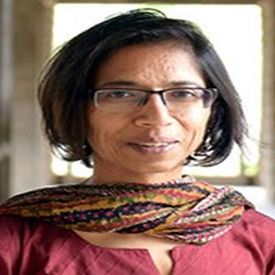The distributional consequences of political reservations
This article identifies and attempts to fill in the gaps in understanding the effects of reservations for Scheduled Castes (SCs) in Panchayats. Using data from a state-wide census, multiple administra...
-
 Chinmaya Kumar
Chinmaya Kumar  M.R. Sharan
M.R. Sharan  28 November, 2023
28 November, 2023
- Articles
Caste-based differences in self-help groups: Evidence from a rural livelihood programme
The National Rural Livelihood Mission aims to increase income and improve wellbeing for rural households. Using survey data from nine states in India, this article analyses the existence of caste-base...
-
 Chandan Jain
Chandan Jain  Krishna Kejriwal
Krishna Kejriwal  Ritwik Sarkar
Ritwik Sarkar  Pooja Sengupta
Pooja Sengupta  05 August, 2022
05 August, 2022
- Articles
India’s Women’s Reservation Act: A big win for governance and beyond
Amidst debates about the recently passed women's reservation act and whether it will reduce gender disparities on the ground, Wattal and Gopalan summarise evidence from a number of randomised evaluati...
-
 Akshara Gopalan
Akshara Gopalan  Urvashi Wattal
Urvashi Wattal  15 December, 2023
15 December, 2023
- Perspectives
Leaders and citizens: Women’s political participation in India
Women’s political participation has emerged as a key element of the discourse around the upcoming state elections in India. In this post, Nalini Gulati and Ella Spencer explore the evidence on vario...
-
 Nalini Gulati
Nalini Gulati  Ella Spencer
Ella Spencer  31 March, 2021
31 March, 2021
- Perspectives
Social identity, health networks, and health knowledge
Health knowledge, driven by education, is a critical factor for the achievement of good health outcomes. Analysing data from the Indian Human Development Survey 2004-05, this article examines how know...
-
 Niels-Hugo Blunch
Niels-Hugo Blunch  Nabanita Datta Gupta
Nabanita Datta Gupta  17 March, 2021
17 March, 2021
- Articles
Matter of mobility: Barriers to women’s work and education, and the dangers at home
As countries across the world implemented lockdowns to mitigate the spread of Covid-19, both women and men have been largely confined to their homes but with differential impacts. In this post, Nikita...
-
 Nikita Sharma
Nikita Sharma  16 March, 2021
16 March, 2021
- Perspectives
Gendered breadwinner norms and work decisions
The male breadwinner norm – the idea that a man must earn more than his wife – can potentially impact labour-market outcomes of married women. Using nationally representative data from India for t...
-
 Sakshi Gupta
Sakshi Gupta  08 March, 2021
08 March, 2021
- Articles
‘Missing’ women in economics academia in India
Economics continues to be among the male-dominated disciplines in the US and Europe. Collating and analysing data from India on university faculty, research presentations at a major annual conference,...
-
 Upasak Das
Upasak Das  Ambrish Dongre
Ambrish Dongre  Karan Singhal
Karan Singhal  05 March, 2021
05 March, 2021
- Articles
International Women’s Day 2021
8 March is observed across the world as International Women’s Day. This year the theme is “choose to challenge”, focussing on the choice to challenge gender bias and inequality, celebrate women'...
-
 I4I Team
I4I Team  03 March, 2021
03 March, 2021
- Perspectives
Employment entry and exit by women in India
While India’s low female labour force participation has been studied extensively in the recent literature, an aspect that has received insufficient attention is the dynamic nature of employment – ...
-
 Soham Sahoo
Soham Sahoo  Sudipa Sarkar
Sudipa Sarkar  19 January, 2021
19 January, 2021
- Articles
Covid-19 spread: Does social and economic diversity matter?
Arresting the spread of Covid-19 requires collective action by communities, which is likely to be more challenging in settings with high diversity. Using district-level data from India, this article e...
-
 Upasak Das
Upasak Das  Udayan Rathore
Udayan Rathore  Prasenjit Sarkhel
Prasenjit Sarkhel  15 January, 2021
15 January, 2021
- Articles
Webinar: Growing concern around violence against women
On 25 November 2020, the International Day for the Elimination of Violence against Women, the India Programme of the International Growth Centre – in collaboration with the Asian Development Researc...
-
 Michele Mary Bernadine
Michele Mary Bernadine  Nalini Gulati
Nalini Gulati  10 December, 2020
10 December, 2020
- Videos
Caste gaps in behaviour and personality traits: A study of university students
While numerous studies have examined gaps in health and educational outcomes across castes, there is little evidence on caste gaps in behavioural preferences and personality traits. Based on incentivi...
-
 Utteeyo Dasgupta
Utteeyo Dasgupta  Subha Mani
Subha Mani  Smriti Sharma
Smriti Sharma  Saurabh Singhal
Saurabh Singhal  04 December, 2020
04 December, 2020
- Articles
Leveraging behavioural insights for informed policymaking
Application of behavioural insights – backed by decades of research in behavioural economics and social psychology – to the design and implementation of social programmes is gaining traction in I...
-
 Steven Walker
Steven Walker  03 December, 2020
03 December, 2020
- Perspectives
International day for the Elimination of Violence against Women
25 November is observed by the United Nations as the International day for the Elimination of Violence against Women. This year, there is a particular focus on the alarming increase in domestic violen...
-
 I4I Team
I4I Team  25 November, 2020
25 November, 2020
- Perspectives
Twitter feed
Tweets by Ideas4IndiaMost Popular Social Identity Posts
A division of labourers: Caste identity and efficiency in India
Castes in India are closely associated with certain occupations and determine the jobs done by millions. This study uses a new dataset to show that a large proportion of workers still work in their ca...
 Guilhem Cassan
Guilhem Cassan  Daniel Keniston
Daniel Keniston  Tatjana Kleineberg
Tatjana Kleineberg  18 November, 2022
18 November, 2022
- Articles
Sex ratios and religion in India and South Asia
In South Asia, low child sex ratios are increasingly an isolated Indian phenomenon. Within India, child sex ratios are ‘normal’ among Christians and Muslims but much lower among Hindus, Sikhs, and...
 Swati Narayan
Swati Narayan  03 April, 2019
03 April, 2019
- Articles
Measuring caste inequality across Indian states
Although recent research on inequality shows that upper castes have the highest levels of material well-being, there is a wide variation in caste inequality across India. Measuring three forms of cast...
 Poulomi Chakrabarti
Poulomi Chakrabarti  13 September, 2021
13 September, 2021
- Articles





 30 March, 2023
30 March, 2023






